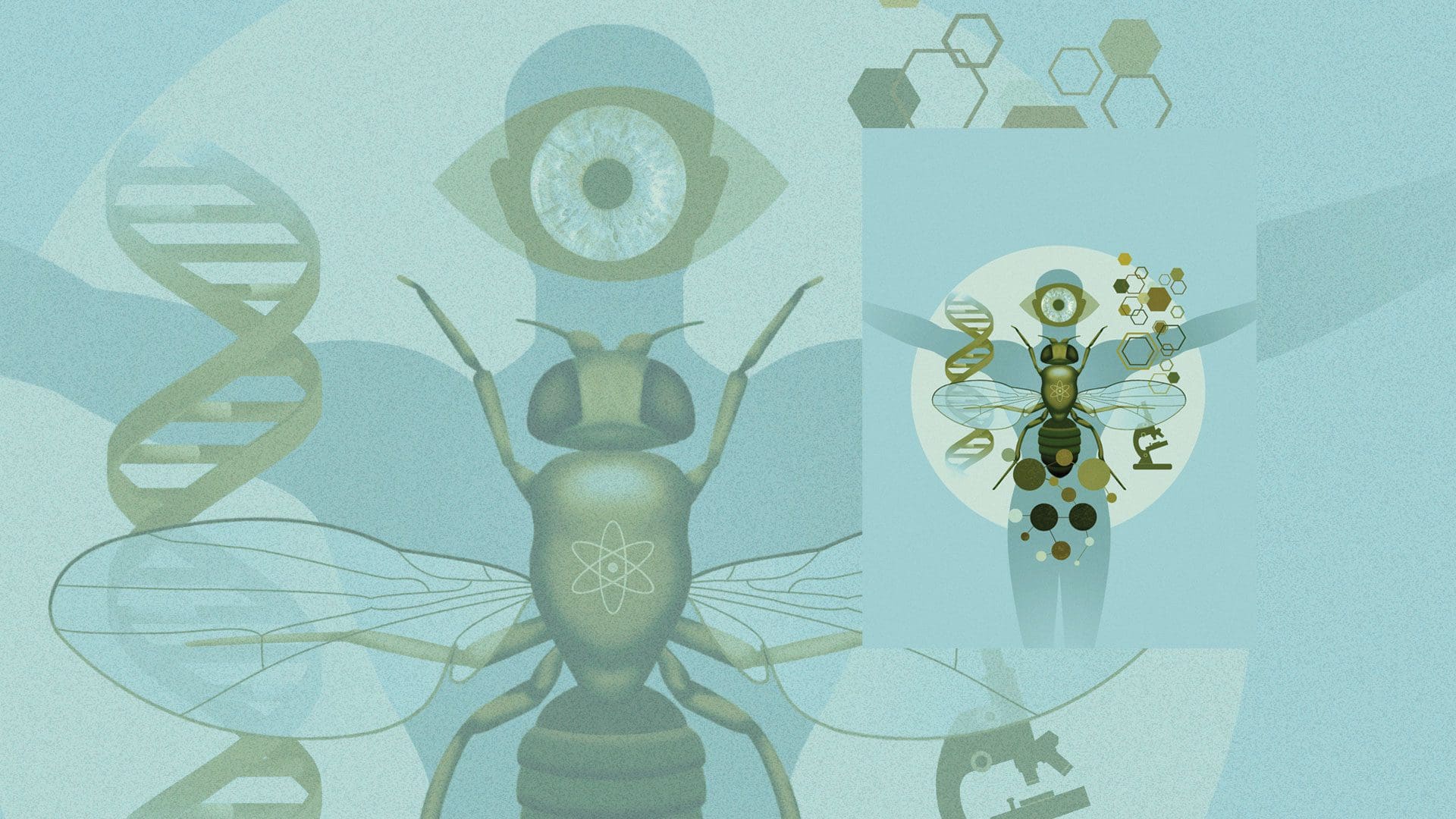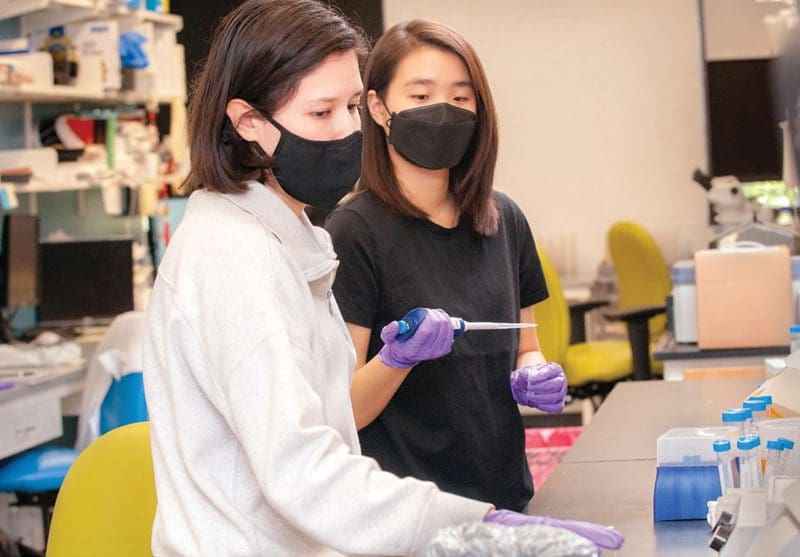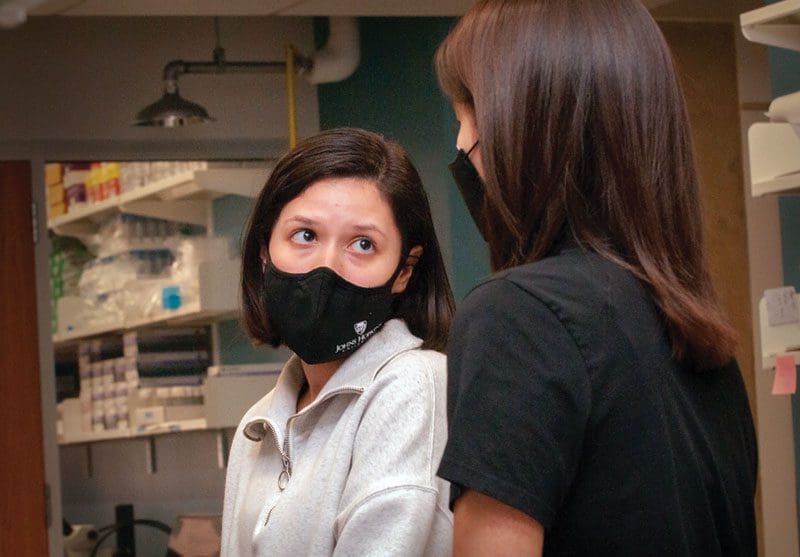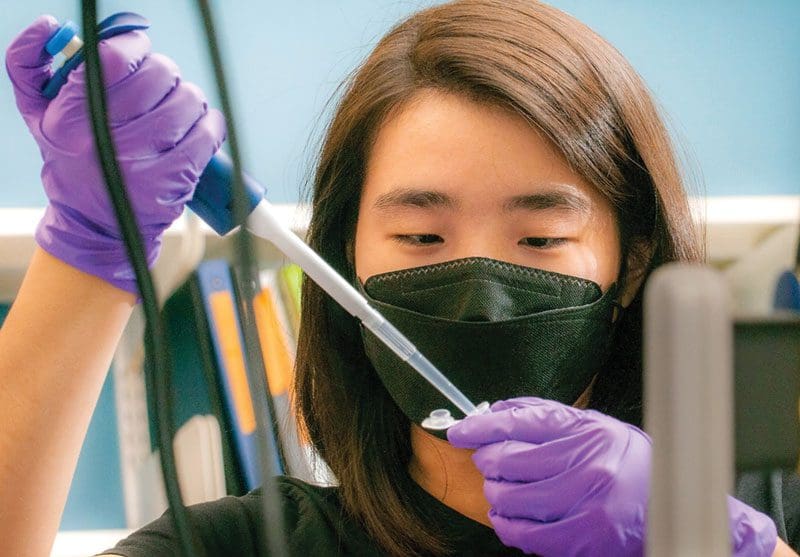The fruit fly. Most of us are familiar with the annoying insects when they swarm above our fruit bowl at home or attack our sandwich at work. Bothersome, yes, but the lowly fruit fly has been teaching us about many areas of biology—including human biology—for more than a century now. And many scientists around the world still prefer fruit flies over all other research organisms. Five of those scientists call the Homewood campus home.
A Fly by Any Other Name
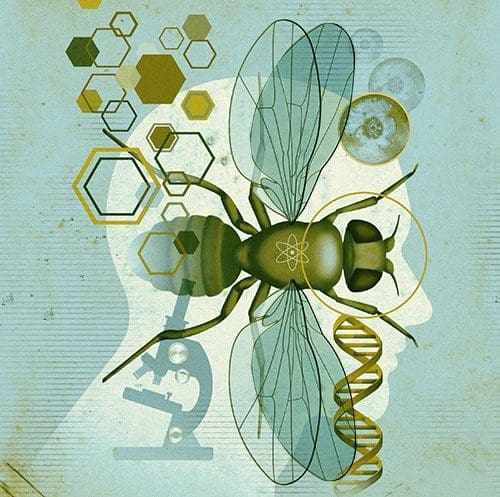
The most studied fruit flies—the ones that have given rise to six Nobel Prizes so far—belong to the species Drosophila melanogaster, but most people just call them Drosophila. There are more than 1,500 species of Drosophila throughout the world, so the ones in your kitchen may not be the same.
The fruit fly has a remarkable breeding capacity under the right conditions. Those conditions are warmth (room temperature is great), food (especially anything soft and sweet), and moisture. In the lab, a female can lay up to 100 eggs per day and they can be sexually mature in as few as eight days, allowing researchers to study several generations of flies in just a month or two
Starting at Johns Hopkins
Fruit flies owe their scientific celebrity as a model organism to Thomas Hunt Morgan, who received his PhD in zoology from Johns Hopkins University in 1890. Around 1908, Morgan, then running a lab at Columbia University, began working with fruit flies to better understand the laws of genetic inheritance and evolution. Using various methods, including radiation, Morgan and his students tried to induce mutations that had visible manifestations that could be tracked from generation to generation.
In 1910, Morgan discovered a white-eyed male. After analyzing its pattern of inheritance, he posited that the eye color gene resides on the male sex chromosome and that other genes probably reside on specific chromosomes, too. For this, and other discoveries about the role of chromosomes, Morgan received the Nobel Prize in physiology or medicine in 1933.
Fruit Flies in Global Labs
Thus began a fruitful endeavor in labs around the world to unlock the secrets of our genes. Although humans have 23 pairs of chromosomes instead of only four, the mechanisms that govern human chromosomes and even the sequences themselves are highly similar. In fact, some 75 percent of human disease genes have counterparts in Drosophila. That is, the fruit fly has similar genes fulfilling similar functions.
This conservation of genes, its simplified genome, and the ease with which mutations can be made and identified have made the fruit fly a go-to organism for answering fundamental genetic questions. Its rapid life cycle, easily identifiable features, and the transparency of its embryos have also made it a go-to organism for answering fundamental questions about development. But don’t limit the fruit fly’s fruitfulness to those two fields. The last two Nobel Prizes for fruit fly research acknowledged discoveries in fields as disparate as circadian rhythms and immune responses.
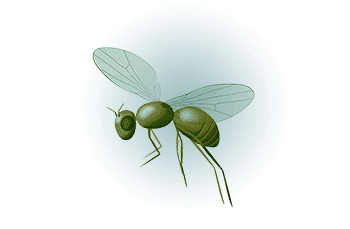
| Fruit Fly Development | Fruit fly (in the lab) |
| Lifespan | 2–3 months |
| Time to sexual maturity | 8–14 days |
| No. of offspring | 30–100/day |
| No. of genes | 14,000 |
| Pairs of chromosomes | 4 |
| Length/Height | 3 mm |
This chart shows averages of development and life expectancy among fruit flies.
Fruit Fly Gonads
As a graduate student, Mark Van Doren needed some convincing that fruit flies could be useful. They didn’t seem very relevant to human health. “I went into fruit fly research kicking and screaming,” says the Krieger School biology professor. With some more experience, he realized that the way things work in flies is shockingly similar to the way they work in humans. He also saw that flies allow scientists to ask deep questions and get answers quickly, with little expense. And he saw how many new techniques and tools are generated by fruit fly scientists, and then freely and openly shared. “That community spirit makes the system even more powerful.”

We are working on how all of the genes are regulated to produce two very different results.”
—Mark Van Doren
For most of his more than 20 years at Johns Hopkins, Van Doren and his lab have been studying sex determination. One key component is the formation of the gonads (ovaries or testes). The gonads contain a special group of stem cells that continuously give rise to new germ cells (eggs or sperm). Surrounding these “germline stem cells,” and aiding them in their work, are specialized support cells.
Discovering Double Sex
About 45 years ago, a so-called transcription factor, called double sex, was identified in fruit flies. Later it—and many relatives—was found in every animal queried, from water fleas to humans. These transcription factors control whether a gonad becomes an ovary or a testis by regulating a group of sex-specific genes.
In particular, double sex controls the sexual identity of the support cells in the gonads. They, in turn, nurture germ cells and influence their sex. “We are working on how all of the genes are regulated to produce two very different results,” says Van Doren. And, to dispel any doubts about the relevancy of his work to human health: The deletion of the double sex counterpart in humans is known to cause disorders of sexual development.
Fruit Fly Research as Cancer Nemesis?
Biology professor Xin Chen is also interested in development. She has been studying fruit flies since she was a graduate student.
Moving into her postdoc, she became interested in adult stem cells, especially germline stem cells. These cells were some of the first stem cells to be identified in any organism. “They are used extensively as a model to understand stem cell behavior,” says Chen. “You can track and visualize them as individual cells, while the fly is still living.”
How Fruit Fly Research Informs Epigenetic Research
At the core of her work is the field of epigenetics, where “epi” roughly means “related to.” She explains that every cell in the body contains the same genes, the same sequences of DNA. What allows gut cells to be gut cells and nerve cells to be nerve cells is the way genes are differentially activated or silenced—and how those regulatory decisions are maintained or altered during cell division. The most prominent regulatory mechanism is simply making genes inaccessible by wrapping them around small balls of protein, called nucleosomes.
Generally, when a cell divides, the two resulting “daughter cells” maintain the identity of the original “mother cell.” So, one skin cell divides into two skin cells. Stem cells are unique in that one daughter cell maintains the stem cell identity, while the other matures into something else, like a sperm cell.

So much was already known about the genetic network that regulates fly development and the whole genome was already sequenced, so there were many questions I could study.”
— Xin Chen
‘Epigenetic Memory’
In 2012, Chen’s group published their findings that, in male fruit fly germline stem cells, one cell remains a stem cell by maintaining the mother cell’s “epigenetic memory,” meaning the same genes are coiled and silent; the other daughter cell resets those settings so that it can develop a new identity as a sperm cell.
Since then, Chen’s research team has continued to reveal more details, including something surprising. Before any cell divides, it must duplicate its chromosomes and then sort the two copies to opposite sides of the cell prior to being divided down the middle. They found that, before germline stem cells divide, the two copies of each chromosome are already coiled around nucleosomes in different ways. And, the sorting machinery can distinguish between the mother’s wrapping pattern and the daughter’s new pattern so that the chromosomes don’t get mixed. Furthermore, if sorting does happen randomly, stem cells are lost over time and cancerous tumors can grow because the cells are being regulated in a confused manner. They don’t know who they are or what to do.
Chen explains, “Tumors are cells that keep dividing without a clear function. Since stem cells are supposed to divide frequently (to replace lost cells in tissues like the skin), they can more easily become cancerous.” Her discoveries about the thin line between a stem cell and a tumor add to a large body of information about cancer’s sinister mechanisms. This is gained through the sacrifice of countless fruit flies.
The Eyes Have It
Cellular identity is also the focus of the work done by Bob Johnston, an associate professor of biology. In general, Johnston wants to understand how cellular identities are determined in a developing organism. Broadly, he says there are three ways, but one particularly captures his curiosity: when a cell’s “choice” seems to be random. To uncover the inner workings of this decision-making, which occurs in many cell types in many organisms, Johnston studies a small population of cells in the fly eye.
Genes and Cell ‘Choices’
Each fly eye has about 800 units, called ommatidia, each of which contains eight cells. Those cells are called photoreceptors, numbered R1 to R8. These photoreceptors produce specific pigments that absorb light at different wavelengths, informing the fly’s vision. Photoreceptor R7 has two pigment options, rhodopsin 3 (Rh3) and 4 (Rh4). The cells choose between the pigment options randomly, meaning the outcome can’t be predicted for any given cell. Normally, one-third of R7 cells produce Rh3 and two-thirds Rh4. If you were expecting a 1:1 ratio, Johnston explains why randomness doesn’t require it. “Think of rolling a six-sided die where numbers one and two produce Rh3 and numbers three through six produce Rh4,” he says.

Think of rolling a six-sided die where numbers one and two produce Rh3 and numbers three through six produce Rh4.”
—Bob Johnston
Underlying the Rh3/4 choice is simply which gene gets turned on. What Johnston’s group has found so far is that this revolves around a protein called spineless, whose job is to control the activity of several relevant genes. In some photoreceptors, the production of spineless halts when its gene is coiled up. Its absence allows the Rh3 gene to turn on. In the other cells, spineless remains present and goes on to activate the Rh4 gene and a repressor of the Rh3 gene. To identify additional factors, including what causes the spineless gene to be coiled or not, the researchers look for mutations that alter the usual ratio of Rh3 to Rh4.
Applying Fruit Fly Research to Humans
For Johnston, the excitement of working on such a fundamental question would be enough. But, he knows that his findings will be broadly applicable to other cell types that make random choices. In fact, Johnston is already testing his question in human cells.
In the human eye, cone cells are the corollary to photoreceptor cells. They produce blue, red, or green pigment and Johnston and his team are trying to figure out their decision mechanism, too. To do so, they’ve taken human embryonic stem cells and developed them into miniature models of the human retina. So far, their data suggests that blue cells are made first. Then green, then red, though there might still be an element of randomness in the green-red decision. When they figure it out, there could be implications for some forms of color blindness and macular degeneration.
Passing the Baton
Although a lot has been learned from fruit fly research in the last 100 years, there are plenty of questions left to be answered. Those questions will be explored by today’s students.
Those characteristics also make it easier for undergraduates to contribute to ongoing research projects in meaningful ways, says Van Doren. In fact, many undergraduates at Johns Hopkins are required to assist in a research lab for two semesters. That’s true for Annabelle Song, a junior majoring in molecular and cellular biology. She’s been working in Chen’s lab for a year because of her interest in genetics. She finds dissection particularly interesting. “I was surprised at how we do it, pulling the flies apart with really sharp tweezers,” she says.
Because fruit flies are so cheap, fast, and easy to work with, we can re-create many of the seminal experiments in a single semester so undergrads can experience the joy of discovery. The same attributes that make flies fantastic for research, make them fantastic for teaching.”
—Mark Van Doren
As is usual in fly labs, Song learned the tricks of the trade by watching others in the lab and then trying it herself. Chen says, “Lectures don’t work so well for this. Mistakes are important. You just have to try it and practice.”
Another student in Chen’s lab is Velinda “Gabby” Vidaurre. She’s a fifth-year graduate student studying the protein SET1, which has a role in regulating germline stem cells. She has guided several students and says she teaches them the way she was taught. “I explain fly genetics and then fly development and the different traits to look for. Then I show them how to sort flies (males from females, etc.) and then they’re ready to make their own crosses [or matings] and maintain their own fly lines,” she says.
The Cycle Goes On
And so the cycle continues and the research goes on. No one can predict what the next breakthrough will be, or even when we will recognize it as important. After all, we have PCR tests for COVID-19 thanks to biologist Thomas Brock’s fascination with bacteria living in the hot springs of Yellowstone. At their core, basic researchers aren’t single-minded prospectors hunting for gold. They are explorers on uncharted waters, following the compass of their curiosity to unknown lands. Providentially, those lands are often crowded with treasures that benefit human health.

More Fruit Fly Research
Meet two more Krieger School researchers whose fruit fly research could add important knowledge to our understanding of some devastating human illnesses.
Gut Check: Nichole Broderick, assistant professor of biology
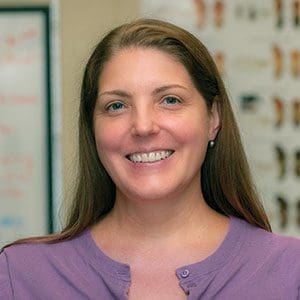
Research: Though fly guts are simpler than humans’, their structure and function are relatively similar. Nichole Broderick’s early work looked at the immune system’s immediate response to microbes in the gut. It involved how the normal microbiome prepares the immune system to respond to disease-causing microbes (pathogens). And, how the immune system keeps the gut’s microbes in check. Now her work is focused on more distant immune effects, which could have broad implications. Including maybe even for patients in the ICU who often have greatly reduced microbial communities.
Insight: “We can actually rear flies in a sterile environment, with sterile food, so they have no microbiome. We’ve found that a lack of microbes throws off the creation and balance of the different cell types needed to respond to disease-causing organisms, as well as wound healing. By adding back specific strains of bacteria to the fly gut, we hope to better understand their interactions with the immune system and the hit or miss reputation of probiotics.”
Germ of an Idea: Tatjana Trcek, assistant professor of biology

Research: Tatjana Trcek studies the initial development of germ cells—a.k.a. eggs and sperm—within the early embryo. Her focus is the RNA granules located at the posterior end of egg cells, called germ granules. In these granules, a subset of mRNA becomes translated and the proteins produced are critical for the formation of germ cells in the developing fly. If that mRNA doesn’t enter the granules, she notes, it won’t be translated and the embryo will be sterile.
Another part of Trcek’s work with implications for human biology: Curiously, like proteins, mRNAs can also aggregate on their own. In Drosophila, this happens all the time with normal mRNAs forming normal granules. But, in humans, mRNA aggregation seems to only happen with mutant mRNAs that are abnormally repetitive, and it causes diseases like myotonic dystrophy and ALS (Lou Gehrig’s Disease).
Insight: “Why do these aggregates form? Is there a mechanism that makes the mRNA assemblies good versus bad? Do they form more often than we think?” asks Trcek. Her current hypothesis is that certain sequences in the mRNAs are bringing them together so that related mRNAs can be regulated as a group.

